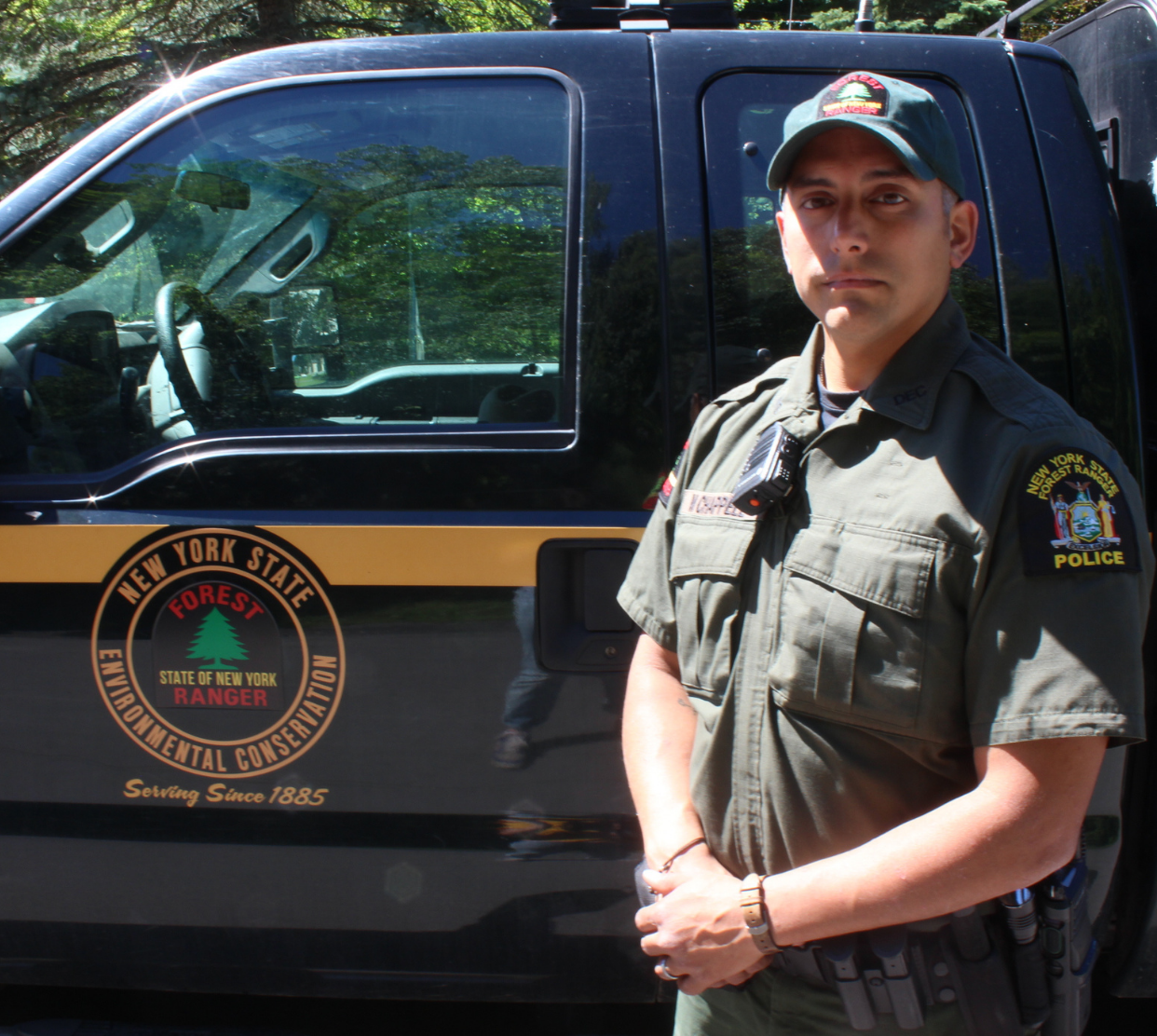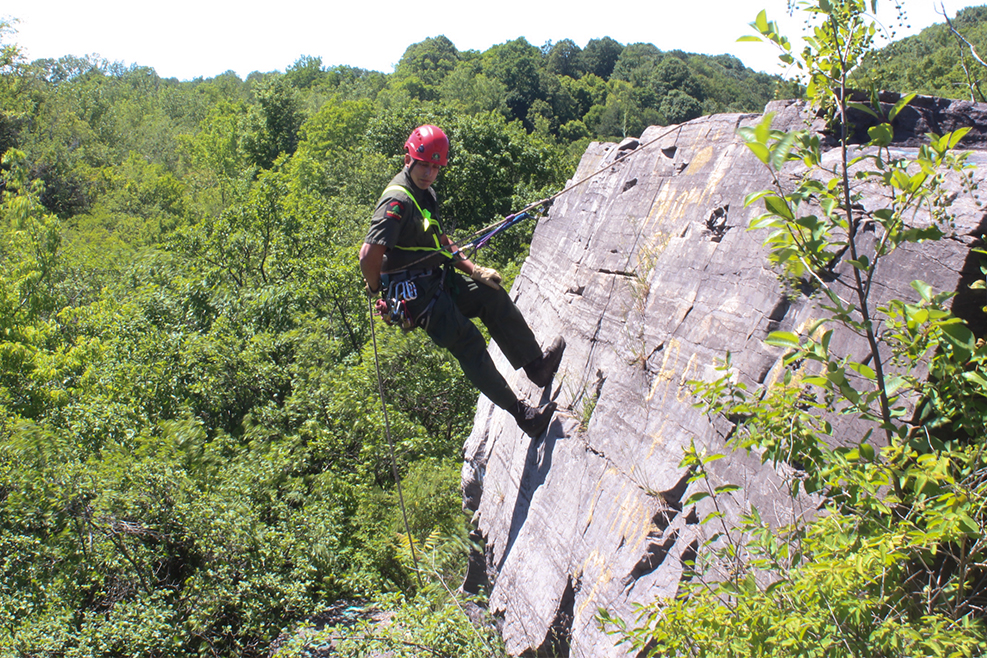This Forest Ranger’s Job is More Than a Walk in the Park
Michael Chappell talks forest fires, search-and-rescue missions, and why representation matters in a field that is overwhelmingly white.


The search and rescue mission lasted more than a week. The group of forest rangers and volunteers sought to find an 86-year-old farmer with dementia. For many, it was the longest search they’d been part of, and as it wore on, attitudes began to shift. Exhausted volunteers started sharing their fears: “He’s not alive anymore. We’re just going to find the body.”
Forest rangers, however, are trained to stay positive, and they recognized that they needed to rally the group’s hope. “We always say that he’s out there, and he just needs our help, and we need to get him that help,” says eight-year ranger veteran Michael Chappell. “We’ve searched an area extensively, and we didn’t find him. He’s not dead, he’s just outside of our search area. [We’ve] got to keep working hard and expand our search.” On the eighth day, they found that tough farmer alive.
Although rescues deliver a lot of drama and often a lot of relief, that is only a portion of what forest rangers do. In addition to search and rescue efforts, they also patrol state lands, enforce laws, and conduct wildfire management. Last year, forest rangers conducted 492 search and rescue missions, extinguished 192 wildfires, and worked on cases that resulted in 3,131 tickets or arrests, according to the New York State Department of Environmental Conservation. The DEC functions to protect the environment and wildlife that inhabit it while keeping visitors safe. The DEC’s forest rangers enforce all New York state laws, with an emphasis on the environmental conservation law.
This work increased during the pandemic. As the spread of Covid-19 mandated social distancing and the closing of public gyms, outdoor activities began to skyrocket. The number of hikes logged increased rapidly throughout the U.S., from around 1.7 million in 2019 to about 4.7 million hikers a year later. With that came added responsibilities for the rangers, who sought to support this influx of users on state lands and assist with the state’s pandemic response. Jeremy Oldroyd, who has served as a New York state forest ranger for 20 years, notes that with or without a pandemic, flexibility is vital to success on the job. “You're not always getting paid to be on call,” he says. “But whenever that call comes in, you pick it up and answer. Anybody we run into, we talk to them, educate them, make sure they're equipped appropriately, and safely using state land. Sometimes it requires you to miss birthday parties and moments with the kids. It comes with the job.”
But despite the huge surge in hiking numbers, those accessing the outdoors fail to represent the diversity of the population. In fact, activities like camping and hiking have been historically inaccessible for people of color. People of color account for approximately 40% of the country’s population; yet, close to 70% of people who visit national forests, national wildlife refuges, and national parks are white, according to the National Health Foundation.
These statistics also reflect the demographics of forest rangers nationwide: 72% of rangers identify as white. Maryland park ranger Angela Crenshaw is the only African-American female park ranger on her staff, and she says that is one of many reasons why people of color aren't fully comfortable visiting. “If you see it you can be it,” she says. “When you walk in I want you to see someone that looks like you and someone that you can relate to. Representation is very important.”
Diversity and representation are as important for the rangers as they are for the visitors. Crenshaw says she has to be patient when she educates her co-workers on her experiences as the lone Black female on the roster. “I have a number of co-workers, and I'm the only Black person they talk to regularly,” she said. “I might be their only Black friend. It’s tough and tedious, but I am able to make them comfortable with me and those that look like me, allowing them to serve all of our guests much more effectively.”
Making sure you have the experience, the right equipment, and making sure you have a backup plan is key to helping yourself and your loved ones.
Ranger Chappell volunteered to be a part of the NYS DEC Hispanic Heritage Awareness series found on YouTube that highlights and celebrates forest rangers of Hispanic backgrounds. Public outreach and education is extremely important to Chappell and to the DEC rangers’ mission. Born in Chile, Chappell identifies as Indigenous and Hispanic and encourages aspiring rangers to feel comfortable pursuing the career regardless of ethnic background.
“I personally feel that my representation in that video from last year was important, because there may be people out there in the state or country from all different backgrounds that are uniquely qualified for this career but don’t know about it,” he says. “Public education is important to me. I try to take any opportunity that I can to highlight the forest rangers. Unfortunately, not many people know what we do.”
Oldroyd has worked alongside Chappell during different incidents and joint patrols and possesses high praise for his fellow ranger. “He has a lot of experience and brings a lot of that to the job, so I really enjoy working with him,” Oldroyd says. “Whenever we need something, we can count on him. All of us bring a whole bunch of different experiences. We can all learn from each other and draw from those experiences to be better rangers.” Upstate Unearthed interviewed eight-year ranger veteran Chappell about what it’s like to earn a paycheck tackling forest fires, working outside most days, and helping to save newbie hikers who lose their way.
Upstate Unearthed: Last year, there was a record number of new hikers in upstate New York because of the pandemic. How have you and the DEC adapted to more crowded trails and working with these inexperienced visitors?
Ranger Michael Chappell: That was a challenge. Not only did we have our core mission, but we also were a large part of the state's effort to fight Covid-19. The state called on our divisions to help manage the pandemic and all the sampling sites. So, a lot of rangers were also tasked to manage these sites as incident commanders, or in various other roles like operations chief or planning chief. It was a challenge to balance the influx of users on state land, and also help the state with the pandemic response. We were able to rise to the challenge.
U.U.: So what has the DEC done to ingratiate the new inexperienced visitors?
M.C.: Public outreach and public education. We teach several different classes, like the basic wildfire suppression course, the basic search rescue course, and the basic online search skills course. Also, talking to people every day, and educating the public on how they can better utilize the state land and the public land that's out there. Also, how to better prepare themselves for any type of situation so that we're not needed, and you don't get yourself in a sticky situation where we will have to come and rescue you or you don’t start a wildfire and I have to put it out.
U.U.: What does a typical day as a forest ranger look like?
M.C.: There is no typical day in the life of a forest ranger, which is one of the greatest things about this job and why I love it so much. No two days are alike. I was just patrolling around, making sure that whoever's using state land is doing so safely and within the confines of the law. And I came home and ended my tour. And then a couple hours after, I got a call for a wildfire. Even before I got home from the wildfire, I get a notification about a search. And thankfully that certain subject was found before I even responded but we could have any incident on any day in any weather, so we must be prepared for it.

Ranger Chappell served 11 years in the U.S. Army before acquiring the Forest Ranger position. He attributes his acquired leadership abilities and his concentration on the job to his prior military experience. Photo by Isabelle Tavares.
U.U.: What is it like tackling a wildfire?
M.C.: When we go and respond to the fire, typically we want to size it up first and make sure we get eyes on the fire activity. We want to figure out how big it is, what's fueling the fire, what the weather is currently doing and what the forecast is within the next couple hours or next 12 hours, depending on how big the fire is. We also look at typography. And from there, we can kind of develop the tactics that we need to fight that wildfire and put it out.
But no two fires are alike. So, you can't respond to one fire like you did the last one. The previous fire before that was a 77-acre wildfire. And there was also a fugitive search in the same incident because the guy who started the fire was also running from the police. Basically, his vehicle caught on fire, and he fled his vehicle, and he was in the woods somewhere and we were searching for him and trying to fight the wildfire at the same time.
U.U.: What is your favorite part of the job?
M.C.: Well, out of the three aspects of our job, my favorite would be search and rescue. And that's kind of my niche. There have been several searches that I've been a part of, where, thankfully, we've found the subject. Whenever I'm describing searches to people, I tell them that the biggest thing that we want to do on a search is maintain a positive attitude. We believe that that person is out there, that they're alive, and they need our help. That attitude motivates us to get out and use our time efficiently so that we can help that person as quickly as possible. And so, there are times, especially during longer searches when people's attitudes turn for the worst.
U.U.: What is the most difficult part of the job?
M.C.: You know, you get on some of these searches and there are times when you find the subject deceased. And it’s tough. You always wonder whether there was anything I could have done better. The answer is usually no. We do everything that we can. You do have to tell a family that found your loved one. At least that brings that family some closure, and they're able to properly mourn and grieve for their loved one. Those days are not great days.
U.U.: What advice would you give to the public to make sure that they are staying safe and respecting the natural world while having fun outdoors?
M.C.: Whatever you're doing, just make sure you're taking the proper precautions and planning ahead. In a lot of cases, you really have to rely on yourself when you’re out in the wilderness alone. So, making sure you have the experience, the right equipment, and making sure you have a backup plan is key to helping yourself and your loved ones. Look at the weather, look at what type of clothing you should wear for that weather. What type of foods should you be bringing, what kind of wildlife is in the area? And how can you protect your food from that wildlife? A lot of people don't realize there is wildlife out in the forest. We are the intruders, so we have to make sure that we properly mitigate any of the risks that come with interacting with wildlife. Make sure that you have the light source, if you're caught out after dark or you have the shelter or the fire starter kit, so that you can get your heat and your shelter and your food that's necessary for survival.
U.U.: What would you tell future rangers heading into the field?
M.C.: Keep an open mind and never stop learning. I learn something new every day. I've learned that as a ranger, I really do enjoy learning new things. I'm always on the lookout for new things, new opportunities to learn and become a better ranger so that I can better serve the public. I want to be prepared for everything. I want to have more tools in my toolbox so that I can handle any situation.
U.U.: Given your eight years of experience, what have you learned about yourself that could inspire new rangers who want to help, and what are some of the necessary steps to obtaining this career?
M.C.:One of the requirements to becoming a ranger is having a degree in environmental science, whether that's an associate degree and appropriate field experience or a bachelors. If you're interested in this job, get that degree in some kind of environmental science field. A lot of people think that because we're police officers, they should have a degree in criminal justice or something like that, which is not necessary. All the law enforcement skills that you need to learn for this job you get taught at the academy. Second, you should have a love for the outdoors. 90% of this job is being outside every day in all of the elements. Whether it's extreme heat, or the dead of winter, in a blizzard, we have to be able to do our jobs. And we have to be able to do them efficiently, to help the people. And then there's leadership skills, because we, as forest rangers, are very good at managing incidents, whether that's a search and rescue, or a wildfire incident. We have to be able to lead other people whether that’s other rangers, volunteer fire departments, or civilian volunteers from like a search and rescue team.
U.U.: What are some of the misconceptions that people have about Forest Rangers?
M.C.: A lot of people think forest rangers have more power than a state trooper, because we're able to go anywhere, which is not true. It's not like I'm able to walk onto somebody's private property, I still need that probable cause in order to enter. So, I don't have any more power than a state trooper does and a state trooper doesn't have any more power than I do. We focus on different laws. A lot of other people think that forest rangers patrol parks which is really the function of the State Park Police. They have lots of recreational trails that are very groomed with the nice bridges and the nice pathways and things like that while our lands are much more primitive and much more wild.
U.U.: Did you have any doubts or regrets about entering this field?
M.C.: We always say it's not a job, it's a lifestyle and I've never regretted any second of it. I enjoy getting out there and helping people who need help. Even when I’m recreating on my own or with my family, I'm still kind of on the lookout making sure people are doing the right thing and a little bit on patrol. It's just hard to turn off even if I'm not on duty. I see somebody doing something that might be unlawful or unsafe, I see myself stepping in to talk to them and be like, Hey, that's not the safest thing you might want to think about putting some better shoes on, you might want to think about doing this just to be safer. And then people ask, who are you and I tell them I'm a state forest ranger.

Our pursuit of outdoor joy is remiss without the acknowledgement of the occupation of unceded Indigenous land. We are students and journalists working, writing, and living on the land of the Haudenosaunee Confederacy, comprising the Six Nations made up of the Mohawk, Onondaga, Oneida, Cayuga, Seneca, and Tuscarora nations. However, acknowledgement is not enough. Read More.